
A plum is a fruit of some species in Prunus subg. Prunus. Dried plums are most often called prunes, though in the United States they may be just labeled as 'dried plums', especially during the 21st century.

Prunus is a genus of trees and shrubs, which includes the fruits plums, cherries, peaches, nectarines, apricots, and almonds.

Prunus cerasus is a species of Prunus in the subgenus Cerasus (cherries), native to much of Europe, North Africa and West Asia. It is closely related to the sweet cherry, but has a fruit that is more acidic. Its sour pulp is edible.

Rosa rugosa is a species of rose native to eastern Asia, in northeastern China, Japan, Korea and southeastern Siberia, where it grows on beach coasts, often on sand dunes. It should not be confused with Rosa multiflora, which is also known as "Japanese rose". The Latin word "rugosa" means "wrinkled", referring to the wrinkled leaves. Often used as an ornamental plant, it has become invasive in parts of Europe, North America and South America.

A cherry blossom, also known as a Japanese cherry or sakura, is a flower of trees in the genus Prunus or the Prunus subgenus Cerasus. Wild species of the cherry tree are widely distributed, mainly in the Northern Hemisphere. They are common in East Asia, especially in Japan. They generally refer to ornamental cherry trees, not cherry trees grown for their fruit. The cherry blossom is considered the national flower of Japan.
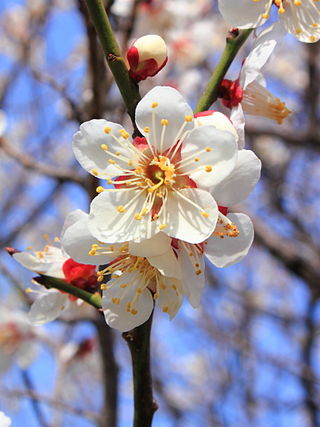
Prunus mume is a Chinese tree species classified in the Armeniaca section of the genus Prunus subgenus Prunus. Its common names include Chinese plum,Japanese plum, and Japanese apricot. The flower, long a beloved subject in the traditional painting and poetry of Sinospheric countries, is usually called plum blossom. This distinct tree species is related to both the plum and apricot trees. Although generally referred to as a plum in English, it is more closely related to the apricot. In East Asian cuisine, the fruit of the tree is used in juices, as a flavouring for alcohol, as a pickle, and in sauces. It is also used in traditional medicine.

Hibiscus syriacus is a species of flowering plant in the mallow family, Malvaceae. It is native to south-central and southeast China, but widely introduced elsewhere, including much of Asia, both in the east and the west. It was given the epithet syriacus because it had been collected from gardens in Syria. Common names include the rose of Sharon,, Syrian ketmia, shrub althea, and rose mallow. It is the national flower of South Korea and is mentioned in the South Korean national anthem.
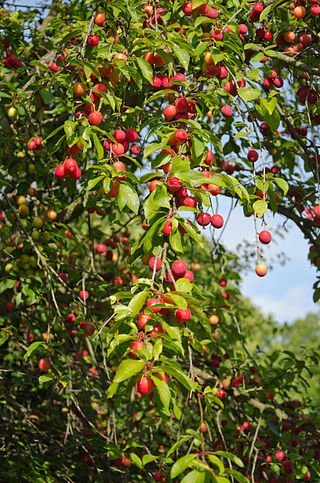
Prunus cerasifera is a species of plum known by the common names cherry plum and myrobalan plum. It is native to Southeast Europe and Western Asia, and is naturalised in the British Isles and scattered locations in North America. Also naturalized in parts of SE Australia where it is considered to be a mildly invasive weed of bushland near urban centers.

Prunus serrulata or Japanese cherry is a species of cherry tree that grows naturally in Japan, China, and Korea, and it also refers to a cultivar produced from Prunus speciosa, a cherry tree endemic in Japan. Historically, the Japanese have developed many cultivars by selective breeding of cherry trees, which are produced by the complicated crossing of several wild species, and they are used for ornamental purposes all over the world. Of these, the cultivars produced by complex interspecific hybrids based on the Oshima cherry are also known as the Cerasus Sato-zakura Group.

Wisteria floribunda, common name Japanese wisteria, is a species of flowering plant in the family Fabaceae, native to Japan. Growing to 9 m (30 ft), Wisteria floribunda is a woody, deciduous twining climber. It was first brought from Japan to the United States in the 1830s. Since then, it has become one of the most highly romanticized flowering garden plants. It is also a common subject for bonsai, along with Wisteria sinensis.

Rosa chinensis, known commonly as the China rose, Chinese rose, or Bengal rose, is a member of the genus Rosa native to Southwest China in Guizhou, Hubei, and Sichuan Provinces. The first publication of Rosa chinensis was in 1768 by Nikolaus Joseph von Jacquin in Observationum Botanicarum, 3, p. 7 & plate 55.
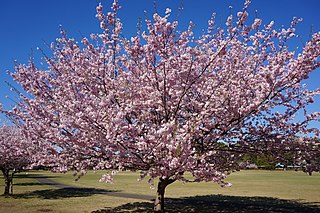
Prunus × subhirtella, the winter-flowering cherry, spring cherry, or rosebud cherry, is the scientific name for the hybrid between Prunus itosakura and Prunus incisa. It is a small deciduous flowering tree originating in Japan, but unknown in the wild.

Prunus subg. Prunus is a subgenus of Prunus. This subgenus includes plums, apricots and bush cherries. Some species conventionally included in Prunus subg. Amygdalus are clustered with plum/apricot species according to molecular phylogenetic studies. Shi et al. (2013) has incorporated subg. Amygdalus into subg. Prunus, thereby including almonds and peaches in this subgenus. The species in this subgenus have solitary flowers or 2–3 in a fascicle.
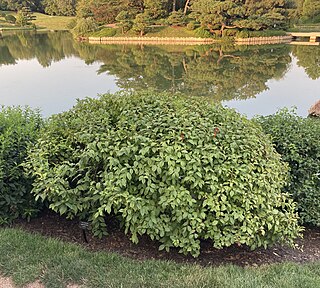
Prunus jacquemontii, sometimes called Afghan cherry, Afghan bush cherry, Afghan dwarf cherry, or flowering almond, a name shared with Prunus triloba, is shrub which originates from Afghanistan, India, Pakistan, Tajikistan, and Tibet. The species name refers to French botanist Victor Jacquemont. It has slender leaves that are elliptical or obovate. The flowers are pink and grow in clusters of 2-3 blossoms with short petals.

Prunus 'Kanzan' is a flowering cherry cultivar. It was developed in the Edo period in Japan as a result of multiple interspecific hybrids based on the Oshima cherry.

Prunus glandulosa, called Chinese bush cherry, Chinese plum, and dwarf flowering almond, is a species of shrub tree native to China and long present in Japan. It is commonly used as an ornamental tree and for cut flowers.

Prunus alabamensis, the Alabama cherry or Alabama black cherry, is an uncommon or rare species of tree in the rose family endemic to parts of the Southeastern United States. It occurs in the states of Alabama, Florida, Georgia, Mississippi, and South Carolina. It is closely related to and found wholly within the range of Prunus serotina, the black cherry, a much more common and widespread species of Prunus that is also native to the region. Alabama cherry is sometimes considered to be a variety of Prunus serotina, however most authors treat it as a distinct species.

Prunus pedunculata is a species of Prunus known in China as long‑peduncled almond (长梗扁桃). It is native to China, Mongolia and nearby sections of Siberia. A small bush, reaching 1-2 m, its pink flowers allow it to be used as an ornamental. Adapted to cold, arid environments, its many‑stemmed growth habit fixes blowing sand, an important contribution to succession. As Amygdalus pedunculatus Pall., it seems to be being evaluated for its seed oil potential.
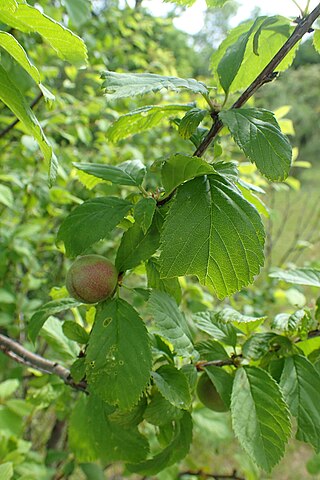
Prunus ulmifolia is species of Prunus native to Central Asia. It is often treated as a synonym of the East Asian species P. triloba. However, they are distinctly different in leaves, flowers and fruits. P. triloba have slightly trilobed leaves, campanulate calyx tubes, unpitted stones, and fruits splitting when ripe, whereas P. ulmifolia have leaves without lobes, cylindrical calyx tubes, stones finely pitted with irregularly branching furrows, and fruits not splitting.
Prunus × arnoldiana is a hybrid species of Prunus discovered growing on the grounds of the Arnold Arboretum of Harvard University. It is a cross of flowering plum, Prunus triloba, and cherry plum, Prunus cerasifera. One of its parents was initially thought to be Prunus tomentosa. It differs from P. triloba in a number of features, the most important being having more copious white flowers. P. triloba flowers are usually pink. Likewise, it differs from P. cerasifera in a number of features, the most important being its more compact, shrubby growth form.


















